![]()
Blue Ribbon Coalition News
The BRC Signs Memorandum of Understanding with the Forest Service
IDAHO FALLS, ID – The United States Forest Service and the Blue Ribbon Coalition (BRC), a national recreational access advocacy group, recently signed a memorandum of understanding (MOU) pledging cooperation between the agency and the organization. This historic document acknowledges the need to actively promote public-private partnerships that encourage responsible use of public lands. Both groups pledged to mutually work toward these goals.
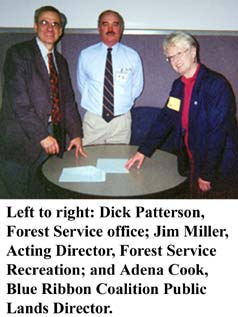 The Blue Ribbon Coalition and the Forest
Service agreed to promote partnerships with local rangers, Blue Ribbon members
and member organizations for on-the-ground trail and facility improvements and
projects as well as educational and user ethics programs. Blue Ribbon and the
Forest Service also pledge to identify and pursue funding opportunities outside
federal appropriations to improve facilities and trails.
The Blue Ribbon Coalition and the Forest
Service agreed to promote partnerships with local rangers, Blue Ribbon members
and member organizations for on-the-ground trail and facility improvements and
projects as well as educational and user ethics programs. Blue Ribbon and the
Forest Service also pledge to identify and pursue funding opportunities outside
federal appropriations to improve facilities and trails.
Adena Cook, Blue Ribbon Coalition Public Lands Director, said, "Blue Ribbon and our member organizations generally have had this kind of cooperative relationship with the Forest Service for many years. Mutually, we have supported the kind of volunteerism that this MOU enables. This document makes it formal. It is a top-to-bottom commitment to work together for the benefit of recreation and the resource.
"Our members and member organizations can approach their local ranger with the assurance that the entire agency supports their willingness to volunteer. Similarly, the local ranger should be able to count on them for help. It is our hope that this MOU stimulates an interest in partnerships at the local level everywhere, as well as identifies new funding opportunities. We appreciate the Forest Service's willingness to work on this document and its willingness to promote its principles."
Don Amador, the BRC's western representative, said, "I think this MOU will help support and encourage many volunteer restoration projects such as the recent tree planting in the Mendocino National Forest in Northern California. The effort to rehabilitate several of the multiple-use campgrounds and staging areas at Fouts Springs that were destroyed by the Trough Fire in the summer of 2001 is a good example of the type of project this MOU will stimulate on national forests throughout the country."
For additional information on this issue, see the Blue Ribbon Coalition's web site at http://www.sharetrails.org. The Blue Ribbon Coalition is a national non‑profit recreation group that champions responsible multiple‑use access to public lands. It represents over 1000 businesses and organizations with 600,000 members.
To view the MOU go to www.sharetrails.org/releases/media/index.cfm?story=100.
Guest Commentary and Overview of Boxer/Environmental Organizations' Wilderness Push in California
Don Amador
Based on speech given by Don Amador, western representative of the Blue Ribbon Coalition, Inc. presented at Kings Beach, California, and Stateline, Nevada, in March 2002
Introduction: This issue was first brought to my attention last fall by my good friend Sylvia Milligan, who is president of the Redding Recreation Coalition and a strong advocate for access to public lands. She called me and said that a relative of hers who owns property on the west side of the Mendocino National Forest was afraid their property or surrounding lands had been targeted by Senator Barbara Boxer and the California Wilderness Coalition (CWC) for designation as a federal wilderness area.
At about the same time I received a copy
of the proposed forest plan revision documents from the so-called Enterprise
Forests in southern California. The Los Padres, Cleveland, Angeles and San
Bernardino National Forests
were asking the public for feedback on new forest plans that contained a
substantial amount of new proposed Wilderness areas or Wild and Scenic
River
designations. 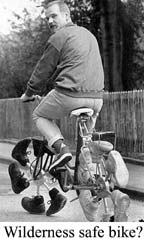
Through November and December 2001 I continued to monitor email traffic from various access leaders who were going to meetings at their boards of supervisors regarding potential Wilderness designations in their respective counties. However, my red-flag meter had not yet risen because it is widely known that CWC and other preservationist groups have longed for more Wilderness in California for many years and this could be just another failed attempt on their part to enact more land closures.
In early January 2002 I realized that this effort by the CWC to ban off-highway vehicles (OHVs), mountain-bikes (MTBs), four-wheel drives and snowmobiles and close roads and trails on 7 million acres of prime California forest and desert recreation lands was serious when I got a call from my MTB friends in the Southern Sierra. They had information based on good authority that the Forest Service had been meeting with representatives of the CWC or Sierra Club and Senator Boxer's staff in 2001 to review maps and details of new potential Wilderness areas in the Greenhorn Ranger District (RD) of the Sequoia National Forest. In fact, over three-quarters of the Greenhorn RD had been circled by the "greens" as a new Wilderness area.
Because our BRC members had not been successful in obtaining detailed maps or information from either the Forest Service or the greens about new Wilderness proposals, they asked if the BRC and I would file a Freedom of Information Act (FOIA) request on the Greenhorn RD. Concurrent with this FOIA I also sent letters to Senator Boxer and the Regional Council of Rural Counties to express my concerns about more Wilderness designations in California. I suggested that if there are special places that need protection that they should consider supporting the BRC's new Backcountry concept. This communication was important because it established an official dialogue with these two important entities.
I appreciated the Greenhorn RD's quick response with a letter stating they had met with green representatives last fall, and the agency supplied me with copies of two draft maps that showed all the roads and trails that would be closed if this new potential Wilderness area ever became a reality.
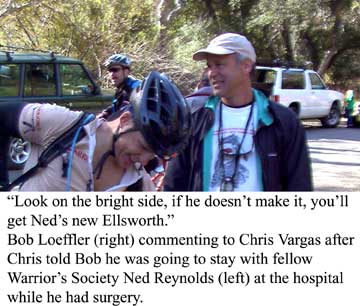 After sharing this FOIA information
with the BRC network (e.g., SAMS [Sierra
Nevada Access Multiple Use Stewardship] Coalition, California Nevada Snowmobile
Association [CNSA], AMA) in California, I was asked to consider broadening the
scope of my FOIA search to other national forests and to the Bureau of Land
Management since it appeared that the CWC had embarked on a viable statewide
effort to promote its Wilderness agenda.
After sharing this FOIA information
with the BRC network (e.g., SAMS [Sierra
Nevada Access Multiple Use Stewardship] Coalition, California Nevada Snowmobile
Association [CNSA], AMA) in California, I was asked to consider broadening the
scope of my FOIA search to other national forests and to the Bureau of Land
Management since it appeared that the CWC had embarked on a viable statewide
effort to promote its Wilderness agenda.
As FOIA information came into my office, it became quite evident that the CWC has also been in formal communication with county supervisors and local land agencies. Hence, I filed California Public Records Act requests with a number of county boards and departments so that the scope of the Wilderness push could be more accurately gauged by BRC and its affiliates.
Summary of FOIA and Public Records Act requests: For the last two to three years, the CWC, the Sierra Club and other green groups have been aggressively marketing their Wilderness agenda to ban multiple-use recreation and resource management on 7 million acres in California. Their targets have been local preservationist-oriented user groups, the International Mountain Bike Association (IMBA), county government, federal land agencies and other members of Congress.
I did receive several phone calls from Boxer's office in response to my letter. They told me they would like to meet with BRC on this issue but have not had the time yet. I told them that our members had many concerns about the Wilderness proposal, and her staff told me that this would be a "new type" of bill that would allow for motorized/mechanized access—using the "cherry-stem concept"—and active resource management with local input and cooperation. Also, Boxer's staff said that they would only go forward with Wilderness designations in counties where the board of supervisors supported it.
What has become clear is that this effort has been anything but inclusive. Rather, the CWC and Boxer's staff have been selectively meeting with IMBA leaders (even though Wilderness designation bans MTB use) and other green groups while formally ignoring national and regional multiple-use access groups like the BRC, the American Motorcyclist Association, the SAMS Coalition and the CNSA.
Using the false promise of access for
motorized and mechanized recreation and resource use within the new Wilderness
boundaries, the CWC and Boxer are attempting to get buy-in and support from some
access groups, county governments and resource-based industries. The greens
claim by using "cherry stems" (a concept that allows for a narrow use corridor
through a Wilderness area) that a number of access groups should sign on. They
also claim that they will even allow mechanized logging in these new land
withdrawals in an attempt to satisfy the fire concerns of many rural
communities. OHV clubs, ranchers, cabin owners and equestrians who trailer their
horses to the forest should not be mislead by the hollow access tenets of the
cherry-stem concept.
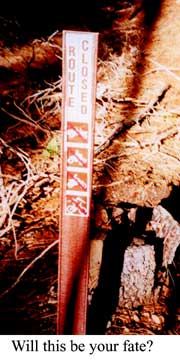
Luckily, a growing number of county governments and access groups are beginning to realize that Boxer's Wilderness agenda is nothing but more of the same old story. Many counties have passed resolutions against more wilderness areas. Access groups now understand that cherry-stemmed routes are a pipe dream that often turns into an "access nightmare."
Listed below is a compilation of reasons why the Boxer/CWC Wilderness proposal is unacceptable. This information is a digest from various sources including Alpine County and other county governments and feedback from federal land managers, FOIA and Public Records Act requests, and multiple-use leaders.
Cherry –Stemmed Routes: While this concept sounds reasonable, it often fails to live up to its access promise. It must be remembered that motorized/mechanized use via the cherry-stemmed concept is only an "allowed" use, not a prescribed use. The Gasquet-Orleans road in the Six Rivers National Forest was originally cherry-stemmed in the California Wilderness Act of 1984, yet in the early 90s it was closed to motorized access because that use was not compatible with "Wilderness values." Four-wheel drive use on the BLM's Black Sands Beach in northern California was recently banned because the agency said, "OHV use is not compatible with Wilderness values."
The passage of the California Desert Protection Act had as one of its "access foundations" the cherry-stemmed route to get buy-off from access groups and multiple-use legislators. Yet, when the final version of the bill was released or went into conference committee, most of those routes were erased from the legislation. Even the Glamis Sand Dunes in Imperial County was a cherry-stemmed recreation area that the OHV community was promised as a bone, yet today the very groups that pushed the original act have targeted that area for closure as well.
A Forest Service resource specialist told me that another reason the cherry-stemmed route does not work in the long term is because it causes "management problems" for the agency. Again, this dilemma for the agency
derives from the fact that cherry-stemmed OHV and MTB use is only an allowed activity that does not
mesh well with the very strict management or non-management directives for federally designated Wilderness.
Disputed designation of "Roadless" area or areas considered "eligible" for wilderness designation: Comments from members of the public familiar with Forest Service lands indicate that the current maps (Forest Service or Wilderness Coalition maps, despite reported years of ground proofing by Wilderness Coalition members) do not accurately depict roaded areas, where snowmobile and mountain bike activities are prevalent. Lack of accurate USFS road inventories is a common problem shared by many counties and states and must be corrected before these maps can be relied upon for any purpose, including evaluation of all existing areas that potentially qualify as public rights-of-way established under RS 2477. There also was some confusion as to the definitions used by the Wilderness Coalition in its determination of "eligible" areas and how this criteria was developed and uniformly applied throughout the state.
Lack of Comprehensive information from the Wilderness Coalition: In response to various inquiries regarding the scope of the Wilderness proposal, both statewide and specific to the Sierra Nevada, Wilderness proponents are not prepared to provide comprehensive, accurate information. In addition, maps that illustrate the counties as a whole, rather than in segments, were not provided as promised. Opening statements made by Wilderness proponents in Alpine County regarding the loss of public land in California (at the rate of 97 acres per day over an unspecified period) were not substantiated.
Lack of a comprehensive proposal:
The Northern California Director for Senator Boxer declared that Senator Boxer
would determine what areas would be included in a wilderness bill. Although
there was no indication of what areas the Senator may be considering, he
indicated that it would be less than the Wilderness Coalition proposal but more
than the Forest Service recommendation. Citizens are left without a proposal to
evaluate.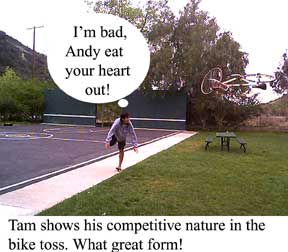
Impact on recreation, historical uses, and public access: Several comments were expressed by both members of the public and Forest Service representatives regarding the restriction to mountain biking and snowmobiling in areas of the Meiss Washoe and Noble Canyon areas, recreational activities that are evidently enjoyed on a limited basis in immediate or in and adjacent to the forest. (The Angeles National Forest made similar observations about impacts to OHV and MTB recreation in the Angeles National Forest) The Mountain Rim Trail, extensively used by mountain bikes, is an example of the existing uses that would be impacted by the proposed wilderness designation. At a minimum, recreational patterns in those areas should be more closely examined, including compiling quantifiable data from recreation-based industries, rural tourism associations and user groups. In addition, concerns regarding the elimination of historic uses, such as grazing and irrigation of meadows, were raised. The ability of an aging population to continue motorized access to these areas was also questioned.
Lack of public notice and participation: Statements made by representatives of the Wilderness Coalition indicate that the review process for identification of lands suitable for Wilderness designation began more than three years ago and that approximately 30 to 40 residents of the county support the proposal. Obviously this does not represent the opinion or interests of the entire county, and no published notice or public hearings have been conducted to determine the sentiments of other residents and interested parties. Clearly, more public outreach is needed.
Potential recommendations: The Wilderness Act establishes the criteria for wilderness designation as an "area of undeveloped Federal land retaining its primeval character and influence, without permanent improvements or human habitation, which is protected and managed so as to preserve its natural conditions, and which 1) generally appears to have been affected primarily by the forces of nature, with the imprint of man's work substantially unnoticeable; 2) has outstanding opportunities for solitude or a primitive and unconfined type of recreation; 3) has at least five thousand acres of land or is of sufficient size as to make practicable its preservation and use in an unimpaired condition; and 4) may also contain ecological, geological or other features of scientific, educational, scenic or historical value." Areas included in proposed wilderness legislation must satisfy these requirements. Alpine County would be pleased to assist the senator in matching the land to these criteria.
Unrealistic agency ability to manage lands: Citizens of Alpine County (and other counties) are concerned with the potential for catastrophic wildfire or insect epidemic. Although the Wilderness Act permits the uses of all measures necessary in the control of fire, insects and diseases and the Wilderness Coalition and others recognize that mechanical forest treatments can be accomplished without impairment of the long-term wilderness characteristics, Forest Service policy clearly prohibits, or at best constrains, the uses of mechanical methods. Use of such methods will not boost anyone up the agency's career ladder.
Our access strategy for the Boxer/CWC Wilderness campaign
Back Country Designation: For too long the Wilderness debate has often been portrayed as a battle between the greens who only "want to protect the land" and resource interests who want access and use of the land. The fact that multiple-use interests are just as interested, if not more so, in managing or "protecting" the land for this and future generations is mostly overlooked by the media and the general public.
The anti-access groups continue to push
their will on the American public through crafty legislative proposals such as
Boxer's Wilderness bill or through the courts via eco-lawsuits. In response,
access and recreation groups must forward their own pro-active agenda—an agenda
that preserves the rugged character of our timber and desert lands while
allowing for continued OHV/MTB access and for active management by the land agencies.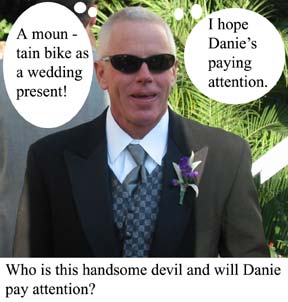
Several years ago the BRC developed a Backcountry concept that asks Congress to develop a new land
designation. This would provide for the protection the public demands for these lands while at the same time empowering the agencies with the necessary management flexibility to respond to recreational demands and address critical concerns of forest health, fire prevention and wildlife enhancement.
Local Grassroots involvement: Continue to support local grassroots groups such as the Lake Tahoe Snowmobile Association and the SAMS Coalition who have been working hard to educate their elected officials and local user groups about the anti-access tenets of Boxer's Wilderness program. Attend your own board of supervisor's meetings and point out the flaws in the CWC proposals and how it will hurt access, recreation and forest management. Join your local club and support its leaders.
Support the BRC and other national regional recreation groups: If you have not done so already, go online and sign up as a BRC member at www.sharetrails.org. While you are there, sign up on our action alert system so you will be notified when a letter needs to be sent to a legislator or land agency. Sign up and support CNSA, as it and the BRC can only be as strong as the support they get from their members.
In closing: Let me quote from the noted anthropologist Margaret Mead, "Never doubt that a small group of thoughtful, committed citizens can change the world; indeed, it's the only thing that ever has."
Tonight, each and every one of you has the power to make an impact. You must become an "Army of One." Develop you own email network of friends, family and colleagues. Take it upon yourself to become informed and responsible for disseminating that information to your own networks. Join and support your local clubs and then join the BRC. By working together, this small group can become a large army that will be victorious in today's land-use battle. We have no choice.
Don Amador
Western Representative
BlueRibbon Coalition, Inc.
555 Honey Lane
Oakley, CA 94561
925.625.6287 Office
Email: damador@cwo.com
|
Ya Ta Hey / Club and General News |
Blue Ribbon Coalition News and Guest Commentary
Late Breaking News and Closing Thoughts
|